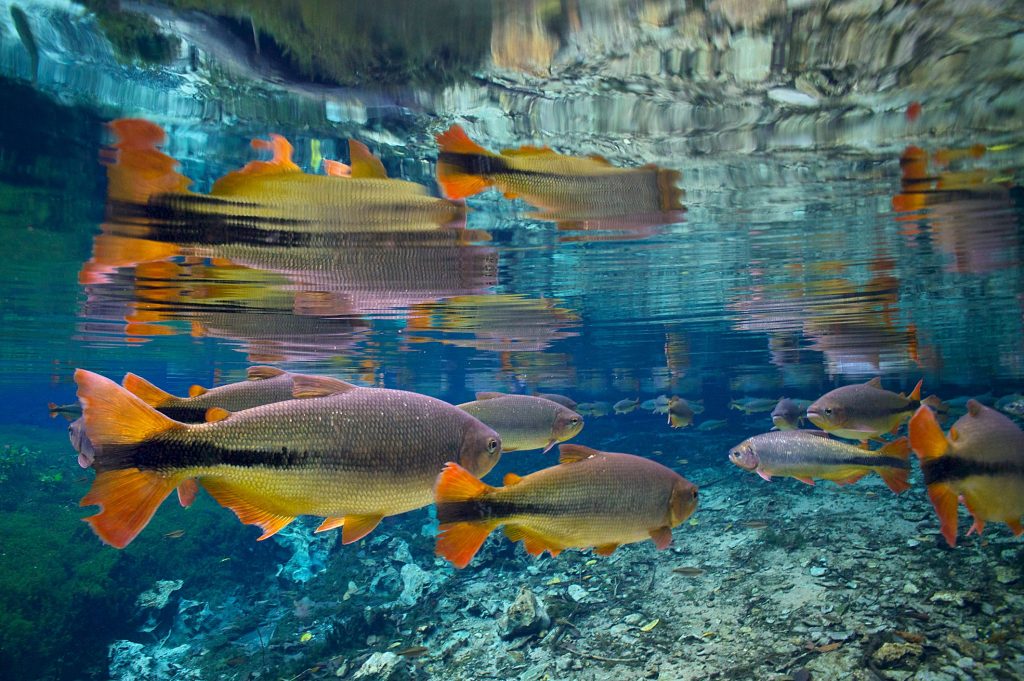
Dubai, United Arab Emirates, 11 December 2023 (IUCN) – Climate change threatens a growing number of species, from Atlantic salmon to green turtles, today’s update to the IUCN Red List of Threatened Species™ reveals. The update, released at the COP28 UN climate conference in the United Arab Emirates, also includes the first global freshwater fish assessment, and highlights the impact of illegal logging and trade on mahogany. Conservation efforts have successfully brought two antelope species back from the brink of extinction, but changing climatic conditions could undermine their future.
The IUCN Red List now includes 157,190 species, of which 44,016 are threatened with extinction.
“Climate change is menacing the diversity of life our planet harbours, and undermining nature’s capacity to meet basic human needs,” said Dr Grethel Aguilar, IUCN Director General. “This IUCN Red List update highlights the strong links between the climate and biodiversity crises, which must be tackled jointly. Species declines are an example of the havoc being wreaked by climate change, which we have the power to stop with urgent, ambitious action to keep warming below 1.5 degrees Celsius.”
“Today’s update to the IUCN Red List shows the power of coordinated local, national and international conservation efforts. Success stories such as that of the scimitar horned oryx show that conservation works. To ensure the results of conservation action are durable, we need to decisively tackle the interlinked climate and biodiversity crises,” said IUCN President Razan Al Mubarak.
State of the world’s freshwater fish species
Today’s update completes the first comprehensive assessment of the world’s freshwater fish species, revealing that 25% (3,086 out of 14,898 assessed species) are at risk of extinction. At least 17% of threatened freshwater fish species are affected by climate change, including decreasing water levels, rising sea levels causing seawater to move up rivers, and shifting seasons. This compounds threats from pollution, which impacts 57% of freshwater fish species at risk of extinction, dams and water extraction, which affect 45%, overfishing, which threatens 25%, and invasive species and disease, which harm 33%. For example, the large-toothed Lake Turkana robber (Brycinus ferox) – an economically important species in Kenya – has moved from Least Concern to Vulnerable on the IUCN Red List, due to overfishing, climate-change driven habitat degradation and dams reducing freshwater entering the lake.
“Freshwater fishes make up more than half of the world’s known fish species, an incomprehensible diversity given that freshwater ecosystems comprise only 1% of aquatic habitat. These diverse species are integral to the ecosystem, and vital to its resilience. This is essential to the billions of people who rely upon freshwater ecosystems, and the millions of people who rely on their fisheries. Ensuring freshwater ecosystems are well managed, remain free-flowing with sufficient water, and good water quality is essential to stop species declines and maintain food security, livelihoods and economies in a climate resilient world,” said Kathy Hughes, Co-Chair of the IUCN SSC Freshwater Fish Specialist Group.
The Atlantic salmon (Salmo salar) has moved from Least Concern to Near Threatened, with new evidence showing the global population decreased by 23% between 2006 and 2020. Atlantic salmon are now restricted to a small portion of the rivers they inhabited a century ago across northern Europe and North America, due to multiple threats over the course of their long-distance migrations between freshwater and marine habitats. Climate change affects all stages of the Atlantic salmon’s life cycle, influencing the development of young salmon, reducing prey availability and allowing invasive alien species to expand their range. Dams and other barriers block access to spawning and feeding grounds, while water pollution and sedimentation, primarily from logging and agriculture, lead to higher mortality of young salmon. Breeding with escaped farmed salmon threatens many wild populations, and may weaken their ability to adapt to climate change. Mortality due to salmon lice (Lepeophtheirus salmonis) from salmon farms is also of great concern. A significant rising threat is the invasive Pacific pink salmon (Oncorhynchus gorbuscha), which is spreading rapidly across northern Europe.
The updated IUCN Red List also reveals that Central South Pacific and East Pacific green turtles are at risk of extinction, and that big leaf mahogany (Swietenia macrophylla), one of the world’s most commercially sought-after timber trees, has moved from Vulnerable to Endangered on the IUCN Red List.
The updated IUCN Red List includes conservation successes, as well, including the scimitar-horned oryx and the saiga antelope. The scimitar-horned oryx (Oryx dammah) has moved from Extinct in the Wild to Endangered on the IUCN Red List, thanks to conservation efforts that have reintroduced the species to Chad. The Red List status of the saiga antelope (Saiga tatarica), which lives across Kazakhstan, Mongolia, Russia and Uzbekistan, has improved from Critically Endangered to Near Threatened.
Read more about the update to the IUCN’s Red List on IUCN’s website.
For more information or interviews, please contact:
Harriet Brooker, IUCN Media Relations, +44 7960241862, [email protected]
Amy Coles, IUCN Media Relations, +41 794157857, [email protected]


